
Donald Montgomery Hutson, nicknamed "the Alabama Antelope", was an American football player and coach in the National Football League (NFL). In the era of the one-platoon football, he played as an end and spent his entire 11-year career with the Green Bay Packers. Under head coach Curly Lambeau, Hutson led the Packers to four NFL Championship Games, winning three in 1936, 1939, and 1944.
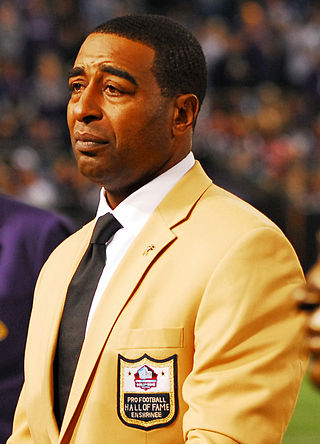
Graduel Christopher Darwin Carter is an American former professional football wide receiver who played in the National Football League (NFL) for the Philadelphia Eagles (1987–1989), the Minnesota Vikings (1990–2001) and the Miami Dolphins (2002). He is widely regarded as one of the greatest wide receivers of all time.
Sterling Sharpe is an American former professional football player who was a wide receiver for the Green Bay Packers of the National Football League (NFL). He played college football for the South Carolina Gamecocks, and played in the NFL from 1988 to 1994 with the Packers in a career shortened by a neck injury. He became an analyst for the NFL Network. He is the older brother of Pro Football Hall of Fame tight end Shannon Sharpe.
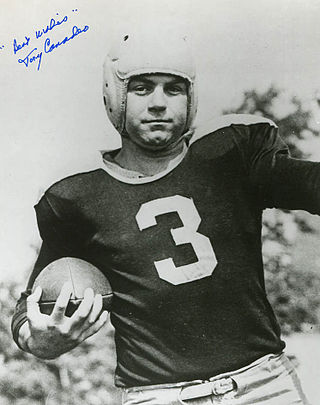
Anthony Robert Canadeo was an American professional football player who was a back in the National Football League (NFL) for the Green Bay Packers from 1941 to 1952, although he missed most of the 1944 season and the entire 1945 season while serving in the U.S. Army during World War II. Born and raised in Chicago, Illinois, he attended Gonzaga University in Spokane, Washington, played football for the Bulldogs, and earned the nickname "Gray Ghost of Gonzaga".

Arnold Charles "Flash" Herber was an American professional football player who was a quarterback in the National Football League (NFL) for 13 seasons, primarily with the Green Bay Packers. During his Packers tenure from 1930 to 1940, he led the league in passing yards and touchdowns three times and won four NFL Championship Games. Herber retired after 11 seasons in Green Bay, but returned in 1944 with New York Giants, where he played his final two seasons. He was inducted to the Pro Football Hall of Fame in 1966.
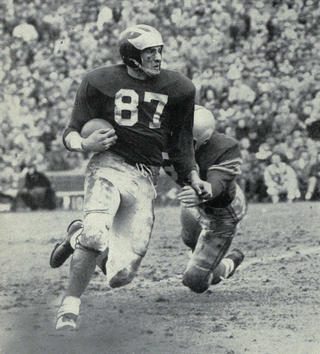
Ronald John Kramer was an American professional football player who was an end in the National Football League (NFL), primarily for the Green Bay Packers. A member of two NFL champion teams with the Packers, he was named to the NFL 50th Anniversary All-Time Team and Green Bay Packers Hall of Fame.
The 1966 NFL Championship Game was the 34th NFL championship, played at the Cotton Bowl in Dallas, Texas. It was the final game of the 1966 NFL season. This was also the last Championship game before the inauguration of the NFL playoffs the following year.

Thomas Franklin McDonald was an American football flanker who played in the National Football League (NFL) for the Philadelphia Eagles, the Dallas Cowboys, the Los Angeles Rams, the Atlanta Falcons, and the Cleveland Browns. He played college football as a halfback for the Oklahoma Sooners. He is a member of the Pro Football Hall of Fame and College Football Hall of Fame.

Boyd Hamilton Dowler is an American former professional football player who was a wide receiver in the National Football League (NFL). He played 12 seasons from 1959 to 1971, 11 with the Green Bay Packers and one with the Washington Redskins.

John Larry Jefferson is an American former professional football player who was a wide receiver in the National Football League (NFL). After playing college football with the Arizona State Sun Devils, he was selected in the first round of the 1978 NFL draft by the San Diego Chargers. He played three seasons in San Diego, where he became the first NFL player to gain 1,000 receiving yards in each of his first three seasons. He was traded to the Green Bay Packers after a contract dispute with the Chargers, and later finished his playing career with the Cleveland Browns.
Franklin Clarke was an American football wide receiver in the National Football League (NFL) for the Cleveland Browns and Dallas Cowboys. He played college football at the University of Colorado.

Cecil Frank Isbell was an American football quarterback and coach. He played 5 seasons in the National Football League (NFL) with the Green Bay Packers, leading them to the NFL Championship in 1939. He retired after the 1942 season to become an assistant coach at his alma mater, Purdue University, and the following year became its head coach for three seasons.

The 1966 Green Bay Packers season was their 48th season overall and their 46th in the National Football League (NFL). The defending NFL champions had a league-best regular season record of 12–2, led by eighth-year head coach Vince Lombardi and quarterback Bart Starr, in his eleventh NFL season.
The 1967 Green Bay Packers season was their 49th season overall and their 47th season in the National Football League (NFL) and resulted in a 9–4–1 record and a victory in Super Bowl II. The team beat the Dallas Cowboys in the NFL Championship Game, a game commonly known as the "Ice Bowl," which marked the second time the Packers had won an NFL-record third consecutive NFL championship, having also done so in 1931 under team founder Curly Lambeau. In the playoff era, it remains the only time a team has won three consecutive NFL titles.
Bobby Joe Conrad is an American former professional football player who was a wide receiver in the National Football League (NFL) for the Chicago/St. Louis Cardinals and Dallas Cowboys. He played college football for the Texas A&M Aggies.
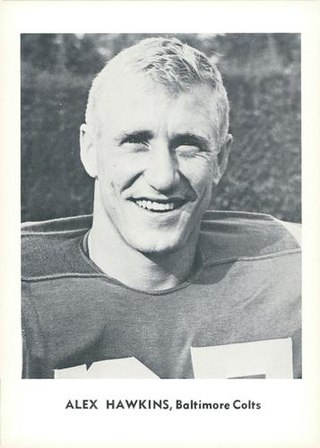
Clifton Alexander Hawkins was an American football player who played professionally as a running back in the National Football League (NFL) for the Baltimore Colts and Atlanta Falcons. He excelled as a special teams player and was a co-captain with the Colts, the first special teams player with this distinction.
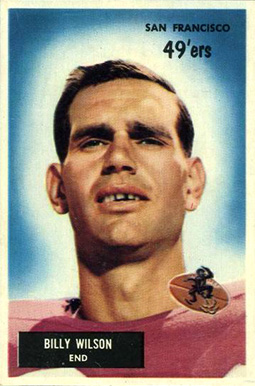
Billy Wilson was an American football wide receiver who played for the San Francisco 49ers from 1951 to 1960. He was named to the Pro Bowl six times.

Robert Mann was an American professional football player in the National Football League (NFL). A native of New Bern, North Carolina, Mann played college football for the Hampton Pirates in 1942 and 1943 and the Michigan Wolverines in 1944, 1946 and 1947. Playing the end position, he broke the Big Ten Conference record for receiving yards in 1946 and 1947. After not being selected in the 1948 NFL draft, Mann signed his first professional football contract with the Detroit Lions, where he stayed for two seasons. He later played for the Green Bay Packers for parts of five seasons until 1954. Mann broke the color barrier for both teams.

Milton Edward Gantenbein was an American football player who played on three championship teams, as an end and as a defensive end for the Green Bay Packers from 1931 to 1940.














